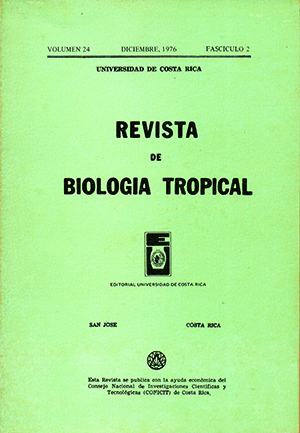Abstract
Cecal microorganisms of mice were categorized and enumerated weekly during the developmental cycle of infection with the whipworm, Trichuris muris. The cecal bacterial population consisted of Escherichia coli, Proteus spp, Acinetobacter lwoffi (Mima polymorpha), aerobic lactobacilli, staphylococci, enterococci, and anaerobes (bacteroides, streptococci, and lactobacilli) in control and T. muris-infected mice. The aerobic lactobacilli and the anaerobes constituted the greatest number of organisms in both groups. In week three there was a de crease in the number of these organisms, and in week four fewer of these and of all other organisms in the worm-infected mice when compared to controls. The most significantly reduced bacterial counts were observed during the period of T. muris self-cure.References
Collins, F. M., D. L Boros, & K. S. Warren 1972. The effect of Schistosoma mansoni infection on the response of mice to Salmonella enteritidis and Listeria monocytogenes. J. Infect. Dis., 125: 249-256.
Drurn, F. L 1966. Relationships of Trichuris muris and Trichuris vulpis to the host tissue. Diss. Abstr. 27: 1652-1653.
Foo, M. C., & A. Lee 1972. Immunological response of mice to members of the autochthol}ous intestinal microflora. Infect. Immun., 6: 525-532.
Fubara, E. S., & R. Freter 1973. Protection against bacterial infection by secretory IgA antibodies. J. Immunol., 111: 395-403.
Gordon, J. H., & R. Dubos 1971. Observations on the normal gastrointestinal flora of the mouse. Ann. N. Y. Acad. Sci., 176: 30-39.
Hoskins, L. C., & N. Zamcheck 1968. Bacterial degradation of gastrointestinal mucins. 1. Comparison of mucus constituents in the stools of germ-free and conventional rats. Gastroenterology, 54: 210-217.
Keeling, J. E. D. 1961. Experimental trichuriasis. I. Antagonism between Trichuris muris and Aspiculuris tetraptera in the albino mouse. J. Parasitol., 47: 641-646.
Knight, R., & L. H. Chew 1974. The interaction between Entamoeba histolytica and Trichuris muris infections in mice. A mer. J. Trop. Med. Hyg., 23: 590-594.
Lee, A., J. Gordon, (hin-Jen Lee, & R. Dubos 1971. The mouse intestinal micro flora with emphasis on the strict anaerobes. J. Exp. Med., 133 : 339-352.
Lotero, H., K. Tripathy & O. Bolaños 1974. Gastrointestinal blood loss in Trichuris infection. Amer. J. Trop. Med. Hyg., 23: 1203-1204.
Nimmo-Smith, R. H., & J. E. D. Keeling 1960. Some hydrolytic enzymes of the parasitic nematode Trichuris muris. Exp. Parasit., 10: 337-355.
Phillips, B. P., & F. Gorstein 1966. Effects of different species of bacteria on the pathology of enteric amebiasis in monocontaminated guinea pigs. Amer. J. Trop. Med. Hyg., 15: 863-868.
Phillips, R. S., G. R. Selby, & D. Wakelin 1974. The effect of Plasinodium berghei and Trypanosoma brucei infections on the immune expulsion of the nematode Trichuris muris from mice. Int. i Pdrasitol., 4: 409-415.
Pike, E. H. 1969. Egg output of Trichuris muris (Schrank, 1788). J. Parasitol., 55: 1046-1049.
Pike. E. H. 1971. Erythrocyte !ife span and hemoglobin levels in mouse trichuriasis. J. Parasitol., 57: 311-315.
Ross, G. W., & R. Knight 1973. Dietary factors affecting the pathogenicity of Entamoeba histolytica in rats. Trans. R. Soc. Trop. Med. Hyg., 67: 560-567.
Savage, D. C. 1972. Survival on mucosal epithelia, epithelial penetration and growth in tissues of pathogenic bacteria. 22nd Symp. Soco Gen. Microbiol., Cambridge, England.
Savage, D. C., J. S. McAllister & C P. Davis 1971. Anaerobic bacteria on the mucosal epithelium of the murine Large bowel. Infect. Immun., 4: 492-502.
Schaedler, R. W., & R. J. Dubos 1962. The fecal flora of various strains of mice. Its bearing on their susceptibility to endotoxin. J. Exp. Med., 115: 1149-1160.
Schaedler, R. W., R Dubos, & R. Costello 1965. The development of the bacterial flora in the gastrointestinal tract of mice. J. Exp. Med., 122: 59-66.
Schedlofsky, S., & F. Freter 1974. Synergism between ecologic and irnmunologic control mechanisms of intestinal flora. J. Infect. Dis., 129: 296-303.
Tannock, G. W., & D. C. Savage 1974. Influences of dietary and environmental stress on microbial populations in the murine gastrointestinal tract. lnfect. lm mun., 9: 591-598.
Wakelin, D. 1967. Acquired immunity to Trichuris muris in the albino laboratory mouse. Parasitology, 57: 515-524.
Wakelin, D., & G. R. Selby 1974a. The induction of immunological tolerance to the parasitic nematode Trichuris muris in cortisone-treated mice. lmmunology, 26: 1-10.
Wakelin, Q. & G. R. Selby 1974b. Thymus-dependency of the immune response of mice to a primary infection with the nematode Trichuris muris. Int. J. Parasitol., 4: 657-661.
Wilcoxon, F. 1945. Individual comparisons by ranking methods. Biometrics Bull., 1: 80-83.
##plugins.facebook.comentarios##

This work is licensed under a Creative Commons Attribution 4.0 International License.
Copyright (c) 1976 Revista de Biología Tropical


